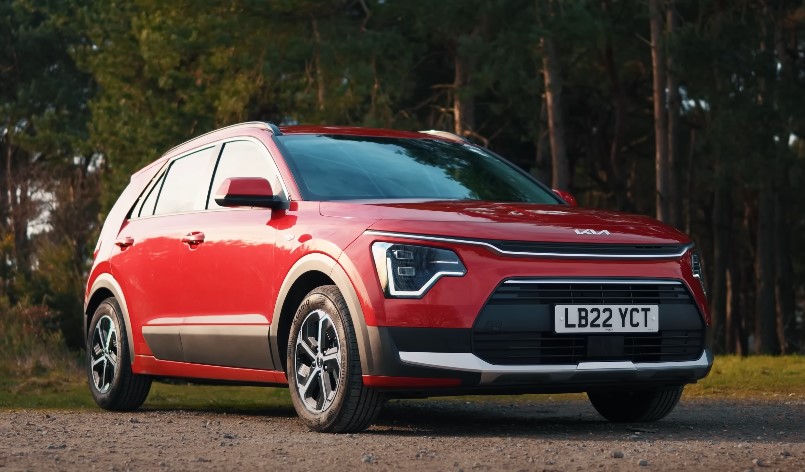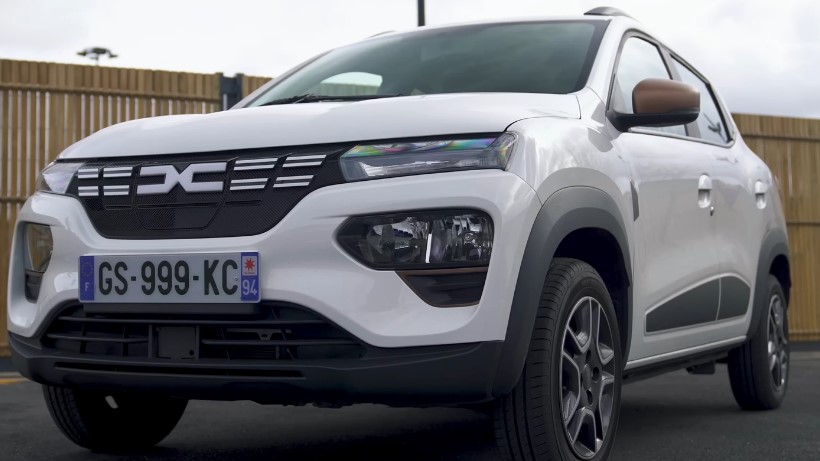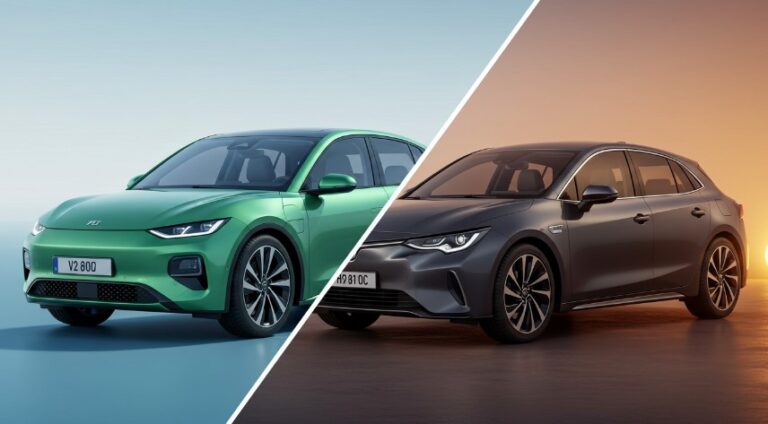In 2025, buying a car is about picking the right color and deciding between an SUV and a sedan, but it’s also about choosing the type of energy that powers your ride.
Electric vehicles (EVs) and hybrids are now center stage, and they’re not going anywhere. But figuring out which one makes the most sense for your life? That takes a little digging.
If you’re trying to decide between going fully electric or sticking with a hybrid setup, you’re not alone. Both types offer a cleaner break from traditional gas-guzzlers, but they do it in very different ways.
Let’s take a clear-eyed look at what you’re getting with each and who they actually work best for.
Key Points
- EVs are cheaper to run but cost more upfront.
- Hybrids offer flexibility and lower entry prices.
- Charging access is key for EV ownership.
- PHEVs suit short commutes with occasional long trips.
Electric Vehicles (EVs)

An EV is powered entirely by electricity – no gasoline engine at all. You plug it in, charge the battery, and that’s it. Cars like the Hyundai Ioniq 5 or Tesla Model S fall into this category.
They’re smooth, quick off the line, and completely silent when running. Depending on the model, you might get anywhere from 137 miles (like with the Dacia Spring) to over 450 miles on a single charge (hello, Mercedes EQS 450+).
Hybrids (Traditional and Plug-In)
Hybrids are a blend of gasoline and electric power, but they come in two flavors:
- Traditional hybrids (like the Toyota Prius) use a small electric motor to support the gas engine. You don’t plug them in; the battery charges on its own while you drive.
- Plug-in hybrids (PHEVs) (think BMW 330e or Jeep Wrangler 4xe) can run purely on electric power for short distances – usually between 20 and 40 miles. Some models stretch that further, like the Range Rover Sport P460e with up to 75 miles of electric range. After that? The gas engine kicks in.
How Much Will It Cost You?

Let’s break it down into upfront costs, tax perks, fuel expenses, and maintenance.
Initial Purchase Price
EVs aren’t cheap. The average price of a new electric car hit $55,614 in January 2025. That’s quite a jump from a typical gas-powered car or even most hybrids.
For example, the 2025 Kia Niro hybrid starts at just under $27,000, while the electric version will cost you close to $40,000. PHEVs often sit somewhere in the middle, expect $30,000 on the low end and up to $58,000 for higher-end options.
| Type | Average Price (2025) |
| EVs | $55,614 |
| Hybrids | Starting around $24,000 |
| PHEVs | $30,000–$58,000 |
Tax Incentives and Rebates
One place EVs and PHEVs do win out? Federal tax credits, up to $7,500 in the U.S., depending on the model and your tax situation. Some states throw in their own rebates too. Traditional hybrids don’t typically qualify, so what you see is what you get.
Fuel and Maintenance Costs
Fuel is where EVs really shine. Charging at home might cost you the equivalent of $1.41 per gallon, compared to $3.15 for gas as of March 2025. You’re also skipping oil changes, transmission repairs, and most of the finicky maintenance gas engines need.
Hybrids still use gasoline, so you’re not cutting out those costs – just reducing them. And PHEVs? They’re the Goldilocks here. If you plug in regularly, your gas station visits can drop dramatically.
| Cost Type | EVs | Hybrids | PHEVs |
| Fuel | ~$1.41/gallon eq | ~$3.15/gallon | Lower if plugged in |
| Maintenance | Lower (fewer parts) | Higher (ICE maintenance) | Higher (complex powertrain) |
How Far Can You Actually Go?

Mileage matters. Here’s how things stand:
EV Range and Charging
Range is the elephant in the garage. EVs are constantly improving, with some models easily clearing 300 miles per charge.
But if you pick something like the Dacia Spring, you’re looking at around 137 miles. Weather, speed, and your driving habits will chip away at that range too.
Charging is its own consideration:
- Level 1 (standard outlet): Adds 2–5 miles per hour. Realistically, a full charge can take a day or more.
- Level 2 (home charger): 20–35 miles per hour. Expect 8–10 hours for a full charge.
- DC Fast Charging: Great for road trips, 30 to 60 minutes for a big boost. But stations aren’t always nearby, especially in rural areas, therefore, off-roading is not an option.
By late 2024, the UK had 70,000+ public charging points across nearly 36,000 locations. The U.S. is catching up fast, but rural areas still lag behind.
Hybrid Range
Traditional hybrids are pretty much gas cars with a fuel-efficiency bonus. They go 500 miles on a tank, but only use the electric motor briefly, maybe 1–2 miles tops.
PHEVs are more flexible. A fully charged battery gives you 20-75 miles of all-electric driving. For most people’s daily commute, that’s enough to skip gas entirely. Then you’ve got the gas engine on standby for longer drives. It’s a solid safety net.
| Type | Electric Range | Total Range |
| EVs | 137–450+ miles | Limited by battery |
| Hybrids | 1–2 miles | ~500 miles |
| PHEVs | 20–75 miles | 500+ miles (combined) |
How Clean Are They?
EVs win the zero tailpipe emissions badge. No fumes, no noise, no guilt when you’re stuck in traffic next to a playground. That said, the environmental impact depends on how your electricity is generated. Charging from solar panels? Amazing. Power grid running mostly on coal? Less impressive, but still cleaner over time than gas.
Battery production does leave a mark. Mining for lithium, cobalt, and nickel isn’t pretty. But over the life of the vehicle, EVs still come out ahead in terms of carbon emissions, especially as more power grids lean on renewables.
Traditional hybrids reduce emissions compared to gas-only cars, but still release pollutants. PHEVs? They’re a mixed bag. If you charge them and keep trips short, emissions stay low. But rely too much on gas, and you’re back to square one.
| Environmental Metric | EVs | Hybrids | PHEVs |
| Tailpipe Emissions | None | Reduced | None (in electric mode) |
| Lifetime Carbon Footprint | Lower (grid-dependent) | Higher than EVs | In between |
| Battery Impact | Higher (large batteries) | Lower | Moderate |
The Ups and Downs of Each Option
- No tailpipe emissions.
- Quiet, responsive ride with instant acceleration.
- Lower fuel and maintenance costs.
- Eligible for federal and state incentives.
- No gas station stops—ever.
- High upfront cost.
- Range anxiety if you’re far from charging stations.
- Charging takes time.
- Rural charging still spotty.
- Battery production isn’t impact-free.
- Great fuel efficiency.
- Lower purchase price (especially traditional hybrids).
- No charging needed (for regular hybrids).
- PHEVs let you commute gas-free, then fall back on gasoline when needed.
- Ideal for long-distance driving or towing.
- Still use gasoline.
- Maintenance on both an engine and an electric system.
- Electric range is short (especially in traditional hybrids).
- Fewer tax breaks.
- Not as smooth or quiet as EVs.
So, Which Should You Get?
View this post on Instagram
There’s no one-size-fits-all answer. It comes down to your driving patterns, where you live, and how much you’re ready to commit to electrification.
You’re a good candidate for an EV if
- You can charge at home or at work.
- Your daily drive is under 200 miles.
- You want to cut fuel and maintenance bills.
- You like quiet, fast acceleration.
- You’re ready to map long trips around charging stops.
EVs are a solid choice for city drivers or anyone already living in a place with reliable charging access. They’re also a good way to stay ahead of future bans on petrol/diesel vehicles (like the UK’s 2035 deadline).
A hybrid might be better if
-
- You drive long distances regularly.
- You don’t have access to charging at home or work.
- You want a lower upfront cost.
- You’d rather not stress over charging stations.
- You want to ease into electrification without going all-in.
Traditional hybrids are great for people who need dependable mileage but aren’t ready for a full switch.
Summary
In the EV vs hybrid debate, you’re not choosing between good and bad. You’re weighing what fits your life best.
EVs offer lower running costs, powerful incentives, and clean performance—if you’ve got the infrastructure. Hybrids are flexible, affordable, and ideal for people who want some of the benefits of electric power without the full commitment.
The more you know about how you drive, where you drive, and what matters most to you, whether it’s price, planet, or practicality—the easier the choice gets.
If you’re still unsure, try tools like plug-in hybrid cost calculators, check local charging maps (like PlugShare), or even rent an EV for a weekend and see how it feels.
You’re not just buying a car in 2025. You’re picking your energy future—and it’s smart to get it right.

